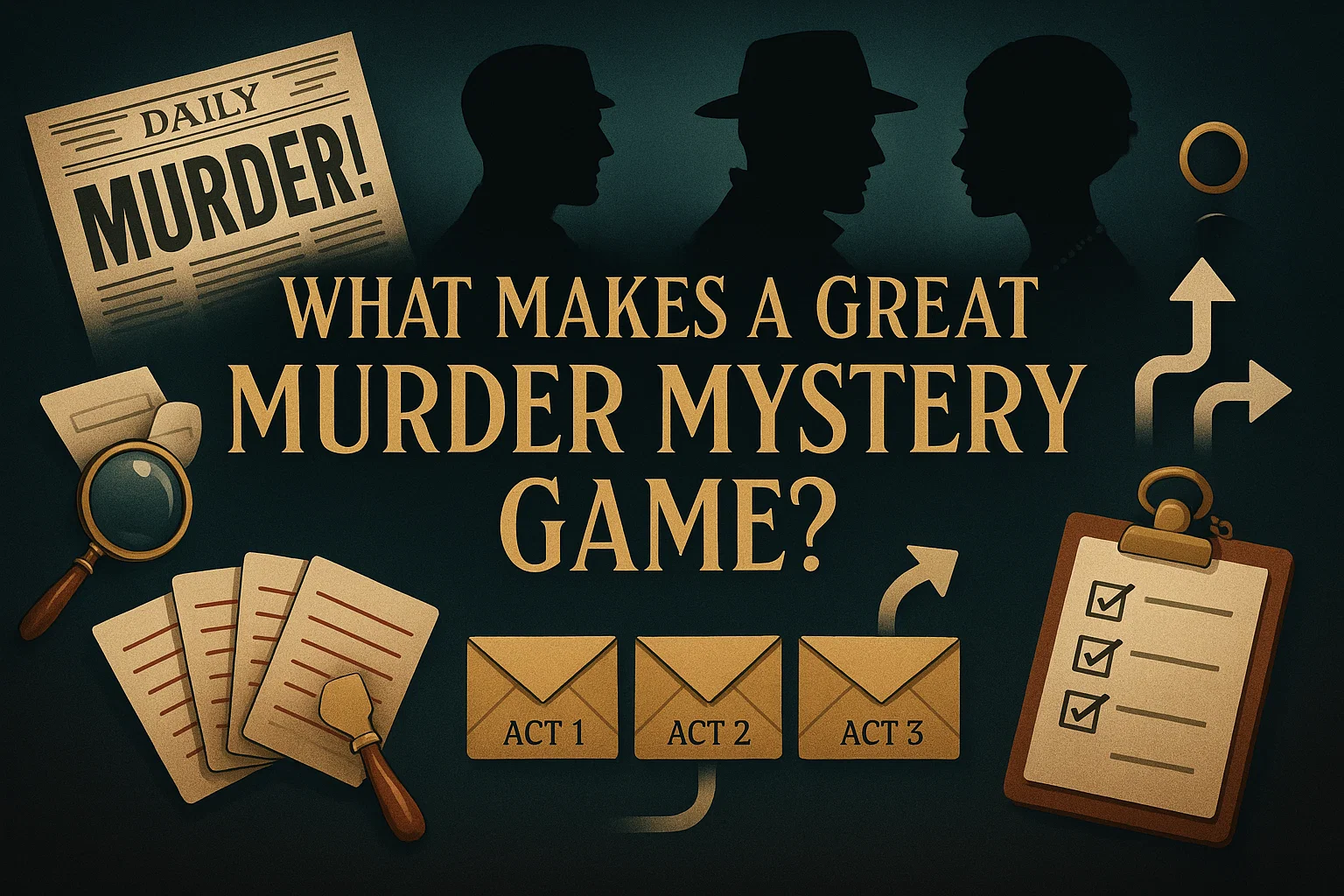What Makes a Great Murder Mystery Game?

What Makes a Great Murder Mystery Game?
From airtight plotting to cinematic atmosphere, here are the essential elements every top-tier whodunit needs.
1. A Strong Narrative Hook
Every great murder mystery begins with a high-stakes premise that grabs players
in the first 60 seconds. Whether it’s a speakeasy shoot-out or a dot-com CEO found
dead on launch night, the setup should instantly answer three questions:
- Who died? (or what crime occurred)
- Why should I care?
- What’s at risk if we fail?
A crystal-clear hook motivates players to dive into their roles instead of waiting for instructions.
2. Memorable, Balanced Characters
Great games provide roles that are:
- Distinct: Easily differentiated archetypes (Flapper vs. G-Man).
- Motivated: Each character has a personal stake—secrets, debts, rivalries.
- Balanced: Similar “spotlight time” and clue weight so no one feels sidelined.
Tip: Include at least two gender-neutral roles for flexible casting, and flag “low-pressure” parts for shy guests.
3. Fair—but Deviously Layered—Clues
The ideal clue web follows the Three-Truths Rule:
- Each puzzle piece is discoverable by Act 2.
- Clues never rely on out-of-game knowledge.
- The solution looks “obvious in hindsight,” rewarding eagle-eyed players.
Use a mix of physical props (evidence photos), written testimony, and behavioral tells to engage different problem-solving styles.
4. Act-Break Pacing & Tension Curves
Stellar mysteries employ a cinematic rhythm:
- Act 1: Exposition & personal motives.
- Act 2: Conflicting evidence and red herrings (the “fog”).
- Act 3: Reveal of key twist, final accusations, unmasking.
Each act should end on a mini-cliffhanger that compels players forward—much like episodic TV.
5. Player Agency & Multiple Paths
Give players choices that matter:
- Optional side quests for extra clues or bonus points.
- Multiple potential endings if no one solves the crime.
- Scoring systems that reward role-play as well as deduction.
Agency turns passive guests into active sleuths, increasing immersion and replay-value.
6. Production Values that Boost Immersion
| Element | Low Effort | High Impact |
|---|---|---|
| Visuals | Black-and-white PDFs | Full-color, art-deco layouts |
| Audio | Playlist link | Act-break narration tracks |
| Props | Printed clue cards | 3-D evidence (bottles, maps, fake ledgers) |
You don’t need Broadway budgets, but polished design elevates perceived value and helps players suspend disbelief.
7. Accessibility & Ease of Hosting
Even the most ingenious plot falls flat if setup is a nightmare. Top-tier kits include:
- One-page Host Overview timeline.
- Pre-labeled envelopes by act.
- Clear content warnings (PG vs. R).
- Digital files optimized for home printers.
A five-minute pre-read should be enough for any host to feel confident.
Eight-Point Quality Checklist
- Compelling one-sentence hook?
- Distinct, balanced characters?
- Clues fair and logically connected?
- Three-act pacing with cliffhangers?
- Meaningful player agency?
- Immersive design & props?
- Host-friendly instructions?
- Content rating fits your audience?
Score 6/8 or higher? You’ve got a great murder-mystery game.
FAQs
How long should a good murder-mystery game last?
2.5–3 hours including dinner breaks keeps energy high without fatigue.
What’s the ideal player count?
8–12 for home games; larger events need specialized kits with team mechanics.
Can one person play the murderer?
Yes—but distribute suspicion evenly so no role becomes an obvious scapegoat.
